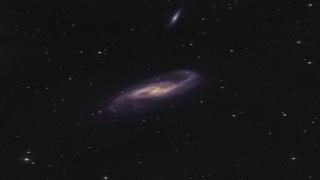Saifollahi, Teymoor; Zaritsky, Dennis; Trujillo, Ignacio; Peletier, Reynier F.; Knapen, Johan H.; Amorisco, Nicola; Beasley, Michael A.; Donnerstein, Richard
Referencia bibliográfica
Monthly Notices of the Royal Astronomical Society
Fecha de publicación:
4
2022
Número de citas
57
Número de citas referidas
52
Descripción
We present an analysis of Hubble Space Telescope observations of globular clusters (GCs) in six ultradiffuse galaxies (UDGs) in the Coma cluster, a sample that represents UDGs with large effective radii (Re), and use the results to evaluate competing formation models. We eliminate two significant sources of systematic uncertainty in the determination of the number of GCs, NGC by using sufficiently deep observations that (i) reach the turnover of the globular cluster luminosity function (GCLF) and (ii) provide a sufficient number of GCs with which to measure the GC number radial distribution. We find that NGC for these galaxies is on average ~ 20, which implies an average total mass, Mtotal, ~ 1011 M⊙ when applying the relation between NGC and Mtotal. This value of NGC lies at the upper end of the range observed for dwarf galaxies of the same stellar mass and is roughly a factor of two larger than the mean. The GCLF, radial profile, and average colour are more consistent with those observed for dwarf galaxies than with those observed for the more massive (L*) galaxies, while both the radial and azimuthal GC distributions closely follow those of the stars in the host galaxy. Finally, we discuss why our observations, specifically the GC number and GC distribution around these six UDGs, pose challenges for several of the currently favoured UDG formation models.
Proyectos relacionados

Huellas de la Formación de las Galaxias: Poblaciones estelares, Dinámica y Morfología
Bienvenida a la página web del g rupo de investigación Traces of Galaxy Formation. Somos un grupo de investigación amplio, diverso y muy activo cuyo objetivo principal es entender la formación de galaxias en el Universo de una manera lo más completa posible. Con el estudio detellado de las poblaciones estelares como bandera, estamos constantemente
Anna
Ferré Mateu

Las Galaxias Espirales: Evolución y Consecuencias
Nuestro grupo pequeño esta bien conocido y respetado internacionalmente por nuestro trabajo inovativo e importante en varios aspectos de la estructura y la evolución de las galaxias espirales cercanas. Usamos principalmente observaciones en varias longitudes de onda, explotando las sinergías que nos permiten responder a las cuestiones más
Johan Hendrik
Knapen Koelstra